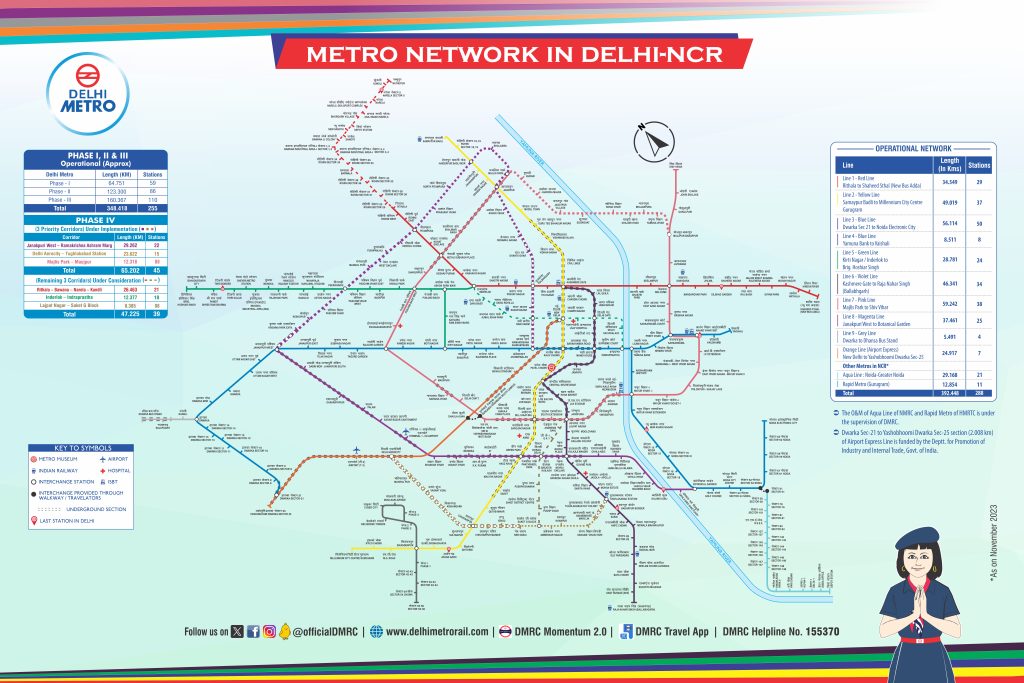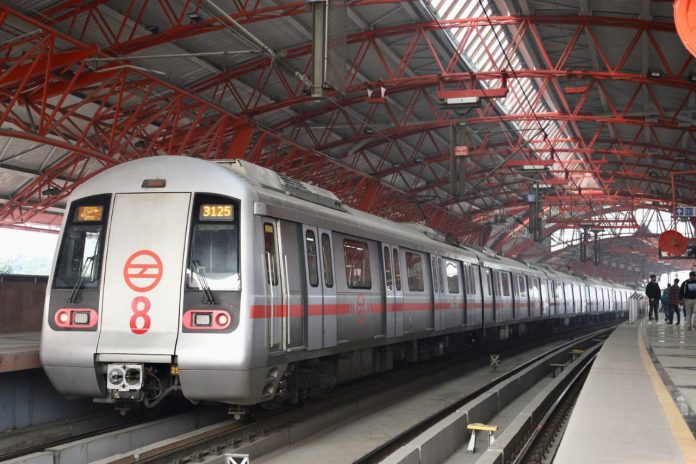About Delhi Metro
i) Delhi Metro’s Colour-Coded Lines
The Delhi Metro Rail Corporation (DMRC) boasts an extensive network with ten color-coded lines facilitating seamless travel. These lines include Violet, Orange, Pink, Magenta, Red, Yellow, Blue, Green, and the recently introduced Grey Line, also known as Line 9.
ii) Grey Line Extension Details
The Grey Line, an approximately 5.19 km extension, is recognized as the shortest Metro route. It connects four stations: Dhansa Bus Stop, Nangli, Dwarka, and Najafgarh. The line commenced operations in 2019, and Dhansa Bus station witnessed an addition to enhance commuter convenience.
iii) Delhi Metro Train Trial
A landmark moment occurred on May 17, 2016, when Delhi Chief Minister Arvind Kejriwal and Union Urban Development Minister M. Venkaiah Naidu inaugurated the first-ever autonomous Metro train trial. This trial marked a significant shift in the operation of Metro trains, evolving from manned to unmanned train operations.
iv) Positive Impact on Traffic
The introduction of the Delhi Metro has transformed the transport landscape in the National Capital Territory, significantly reducing traffic congestion. Residents have lauded the benefits of the Metro Rail Service, contributing to a more comfortable and efficient transportation system.
v) Phased Construction and Expansion Plans
The Delhi Metro’s construction occurred in phases, with Phase I and II completed before the 2010 Commonwealth Games. Ongoing projects include Phases IV and V, expected to conclude by 2023 and 2031, respectively, further expanding the metro network.
vi) Diverse Amenities and Services
Delhi Metro stations offer a range of amenities, including snack and drink booths. Popular dining establishments such as McDonald’s, Nirula’s, and Cafe Coffee Day can be found near key stations. Additionally, IRCTC has established food kiosks providing affordable snacks to commuters.
vii) Budget of Delhi Metro
The DMRC has received substantial financial support and equity investments, exemplified by budgetary allocations such as Rs. 1,156 Crores in the 2017–18 fiscal year’s interim budget and Rs. 3,470.16 crores in the 2014–15 fiscal year’s interim budget.
viii) Service Improvements
To enhance user experience, the Delhi Metro has implemented several service improvements, including the introduction of six- and eight-coach trains on various routes. Additional trains during peak hours and extended journeys on specific routes demonstrate the commitment to meeting commuter needs.
The Delhi Metro stands as a testament to architectural brilliance, cutting-edge amenities, and a paramount focus on security, solidifying its status as a pioneering metro system in India.
Delhi Metro Timings
The Delhi Metro is open from 5 AM to 11 PM, however, specific hours depend on the line and day of the week. The airport express line, for instance, operates from 4:45 AM to 11:30 PM. The following are the times for a few more lines:
- Metro Rapid: 6 a.m. to midnight
- Blue Line: from 5:30 a.m. to 11:30 p.m.
- Pink Line: 6 a.m. to 11 p.m.; Sundays, 8 a.m.
Delhi Metro Route

Line 1: Red Line – Shaheed Sthal – Rithala
Shaheed Stha and Rithala are separated by 34.4 kilometres. This route has a total of 29 stops. The average frequency of the metro trains is every four minutes.
Covered Stations in Line 1:
Major Mohit Sharma, Shaheed Sthal, Hindon, Arthala, Mohan Nagar, and Shyam Park Mansarovar Park, Raj Bagh, Shaheed Nagar, Dilshad Garden, and Jhilmil – Shahdara – Welcome – Seelampur – Shastri Park – Kashmere Gate – Tis Hazari – Pul Bangash – Pratap Nagar – Shastri Naga – Inderlok – Kanhiya Nagar – Keshav Puram, Pitampura, Rohini East, Rohini West, Netaji Subhash Place, Kohat Enclave, and Rithala
| History | ||||||
| Extension date | Termini | Length | Stations | |||
| 25/12/02 | Shahdara | Tis Hazari | 8.3 kilometers (5.2 mi) | 6 | ||
| 03/10/03 | Tis Hazari | Inderlok | 4.1 kilometers (2.5 mi) | 4 | ||
| 31/03/04 | Inderlok | Rithala | 8.9 kilometers (5.5 mi) | 8 | ||
| 04/06/08 | Shahdara | Dilshad Garden | 3.1 kilometers (1.9 mi) | 3 | ||
| 08/03/19 | Dilshad Garden | Shaheed Sthal | 9.6 kilometers (6.0 mi) | 8 | ||
| Total | Shaheed Sthal | Rithala | 34.4 kilometers (21.4 mi) | 29 |
Line 2 (Yellow Line): Samaypur Badli, Delhi – HUDA City Centre, Gurgaon
The 42.2 kilometers of Line 2 runs between HUDA City Centre and Samaypur Badli. This route has a total of 37 stations. Generally speaking, during peak hours, trains on this route run every three minutes on average.
Covered Stations in Line 2:
Samaypur Badli to Rohini Sector 18, 19 to Haiderpur Badli Mor to Jahangirpuri to Adarsh Nagar to Azadpur to Model Town to GTB Nagar to Vishwa Vidyalaya to Vidhan Sabha to Civil Lines to Kashmere Gate to Chandni Chowk to Chawri Bazar to New Delhi to Rajiv Chowk to Patel Chowk to Central Secretariat to Udyog Bhawan to Lok Kalyan Marg to Jor Bagh to INA to AIIMS to Green Park to Hauz Khas to Malviya Nagar to Saket to Qutub Minar to Chhatarpur to Sultanpur to Ghitorni to Arjan Garh to Guru Dronacharya to Sikandarpur to MG Road to IFFCO Chowk to HUDA City Centre
Five phases went into making Line 2 operational:
| History | ||||||
| Extension date | Termini | Length | Stations | |||
| 20/12/04 | Vishwa Vidyalaya | Kashmere Gate | 4 kilometers (2.5 mi) | 4 | ||
| 03/07/05 | Kashmere Gate | Central Secretariat | 7 kilometers (4.3 mi) | 6 | ||
| 04/02/09 | Vishwa Vidyalaya | Jahangirpuri | 6.4 kilometers (4.0 mi) | 5 | ||
| 21/06/10 | HUDA City Centre | Qutub Minar | 14.5 kilometers (9.0 mi) | 9 | ||
| 26/08/10 | Chhatarpur [2] | – | 1 | |||
| 03/09/10 | Central Secretariat | Qutub Minar[3] | 12.53 kilometers (7.79 mi) | 9 |
Line3: The Blue Line, Noida Electronic City – Dwarka Sector 21
operating in Line 3 spanning 57 stops. This course covers a total of 50.56 km. The Delhi Metro’s Blue line formerly ran from Indraprastha to Dwarka. The line was expanded on November 12, 2009, to cover a total of 13.1 kilometres, from Yamuna Bank to Noida City Centre.
6 phases went into making Line 3 operational:
| Blue Line Stations | ||||
| Extension date | Termini | Length | Stations | |
| 31/12/05 | Dwarka | Barakhamba Road | 22.9 km (14.2 mi) | 22 |
| 01/04/06 | Dwarka Sector 9 | 6.5 km (4.0 mi) | 6 | |
| 11/11/06 | Barakhamba Road | Indraprastha | 2.8 km (1.7 mi) | 3 |
| 12/11/09 | Yamuna Bank | Noida City Centre | 13.1 km (8.1 mi)[2] | 10 |
| 14/07/11 | Vaishali | 8.74 km (5.43 mi)[3] | 8 | |
| 30/10/10 | Dwarka Sector 9 | Dwarka Sector 21 | 2.76 km (1.71 mi)[4] | 2 |
| 09/03/19 | The Noida City Centre | The Noida Electronic City | 06.67 km (04.14 mi) | 06 |
| Total | Noida Electronic City/Vaishali | Dwarka Sector 21 | 65.35 km (40.61 mi) | 57 |
Delhi Metro Blue Line Stations List:
- Noida Electronic City
- Noida Sector 62
- The Noida Sector 59
- Noida Sector 61
- Noida Sector 52
- The Noida Sector 34
- Noida City Centre
- Noida Golf Course
- Botanical Garden
- Noida Sector 18
- Noida Sector 16
- The Noida Sector 15
- New Ashok Nagar
- Mayur Vihar Extension
- Mayur Vihar-I
- Akshardham
- Yamuna Bank
- Indraprastha
- Pragati Maidan
- Mandi House
- Barakhamba Road
- Rajiv Chowk
- R K Ashram Marg
- Jhandewalan
- Karol Bagh
- Rajendra Place
- Patel Nagar
- Shadipur
- Kirti Nagar
- Moti Nagar
- Ramesh Nagar
- Rajouri Garden
- Tagore Garden
- Subhash Nagar
- Janakpuri East
- Janakpuri West
- Uttam Nagar East
- Uttam Nagar West
- Nawada
- Dwarka Mor
- Dwarka
- The Dwarka Sector 14
- Dwarka Sector 13
- Dwarka Sector 12
- The Dwarka Sector 11
- Dwarka Sector 10
- Dwarka Sector 9
- The Dwarka Sector 8
- Dwarka Sector 21
Line 4: Blue Line – Yamuna Bank – Vaishali (Branch Line)
Line 4 was completed in January 2010 and runs through eight stops. This path covers a distance of 6.25 kilometers. In July 2011, a minor expansion was completed between the Blue Line branch’s Anand Vihar Metro Station and Ghaziabad’s Vaishali Metro Station-two stations in Ghaziabad. The public could travel the Anand Vihar ISBT – Vaishali route on January 27, 2010.
Covered Stations in Line 4
Yamuna Bank – Laxmi Nagar – Nirman Vihar – Preet Vihar – Karkardooma – Anand Vihar – Kaushambi – Vaishali
Related Posts
Line 5 (Green Line): (Green Line)Inderlok – Brigadier Hoshiyar Singh
One of the newest lines to be introduced to the Delhi Metro system is this one. In addition, following Line 4, it is the second line that provides the standard-gauge corridor. About 29.64 km are covered in total by this route. Line 5 includes 21 stops. The line began to operate on April 3, 2010. The major highway between Kirti Nagar and Ashok Park opened on August 27, 2011.
Stations in Line 5
Inderlok to Ashok Park Main to Punjabi Bagh to Shivaji Park to Madipur to Paschim Vihar East to Paschim Vihar West to Peeragarhi to Udyog Nagar to Surajmal Stadium to Nangloi to Nangloi Railway Station to Rajdhani Park to Mundka – Mundka Industrial Area (MIA) – Ghevra Metro station – Tikri Kalan – Tikri Border – Pandit Shree Ram Sharma – Bahadurgarh City – Brigadier Hoshiyar Singh
Line 6 (Violet Line): Raja Nahar Singh – Kashmere Gate (Ballabhgarh)
In October 2010, Line 6 started operating, running from Central Secretariat to Sarita Vihar. This route contains 34 significant stops for a total distance of 43.285 kilometers. In November 2018, the line was extended to the Raja Nahar Singh Metro Station in Ballabhgarh.
Stations in Line 6
Kasmere Gate – Lal Qila – Jama Masjid – Delhi Gate – ITO – Mandi House – Janpath – Central Secretariat – Khan Market – Jawaharlal Nehru Stadium – Jangpura to Lajpat Nagar to Moolchand to Kailash Colony to Nehru Place to Kalkaji Mandir to Govindpuri to Harkesh Nagar to Jasola Apollo to Sarita Vihar to Mohan Estate to Tughlakabad to Badarpur to Sarai to NHPC Chowk to Mewla Maharajpur to Sector 28 to Badkhal Mor to Faridabad Old to Neelam Chowk Ajronda to Bata Chowk to Escorts Mujesar to Sant Surdas (Sihi) to Raja Nahar Singh (Ballabhgarh).
Three steps were taken to bring Line 6 online:
- Central Secretariat to Sarita Vihar, October 3, 2010
- January 14, 2011: Badarpur to Sarita Vihar
- Central Secretariat to Mandi House, June 28, 2014
- June 8, 2015: ITO to Mandi House
- September 6, 2015: Escorts Mujesar to Badarpur
- 28 May 2017: ITO to Kashmere Gate
- November 19, 2018: Mujesar is escorted to Raja Nahar Singh
Line 7: (Orange Line) Airport Express – Dwarka Sector 21
The Indira Gandhi International Airport is connected to the Dwarka Sector 21 Metro Station and the New Delhi Metro Station via the Delhi Airport Metro Express line. On February 23, 2011, the New Delhi – IGI Airport (T-3) – Dwarka Sector-21 route was made available to the public. This line is 22.7 kilometers long in total. Due to certain technical issues, the service was discontinued from July 7, 2012, until January 22, 2013. Now that it’s reopened, the metro moves at 132 km/h.
Stations in Line 7:
New Delhi Station to Shivaji Stadium to Dhaula Kuan to Delhi Aerocity to Airport to Dwarka Sector 21
Pink Line: Mukundpur Depot – Shiv Vihar
The public was able to access stations from Mukundpur Depot to Durgabai Deshmukh South Campus on March 14, 2018. On October 31, 2018, portions of the road connecting Trilokpuri Sanjay Lake and Shiv Vihar were inaugurated. It is anticipated that further line segments will open in December 2018. With a length of 58.59 kilometers, it is expected to be the longest corridor in the quickly developing metro network of Delhi NCR. There are 38 stations in it at the moment. The Pink Line, also known as the Ring Road Line, runs alongside Delhi’s heavily traveled Ring Road, which has severe traffic congestion every day.
Stations in Pink Line
Mukundpur Depot – Majilis Park – Azadpur – Shalimar Bagh – Netaji Subhash Place – Shakurpur – Punjabi Bagh West – ESI Hospital – Rajouri Garden – Maya Puri to Naraina Vihar to Delhi Cantonment to Durgabai Deshmukh South Campus to Sir Vishweshwaraiah Moti Bagh to Bhikaji Cama Place to Sarojini Nagar to INA to South Extension to Lajpat Nagar – Vinobapuri – Ashram – Hazrat Nizamuddin – Mayur Vihar-I – Mayur Vihar Pocket 1 – Trilokpuri Sanjay Lake – Vinod Nagar East – Vinod Nagar – IP Extension – Anand Vihar – Karkarduma – Krishna Nagar – East Azad Nagar – Welcome – Jaffrabad – Maujpur – Gokul Puri – Johri Enclave – Shiv Vihar
Janak Puri West – Botanical Garden: Magenta Line
The last section of the Delhi Metro’s Magenta Line, which runs from Janak Puri West to Kalkaji Mandir, was inaugurated on May 29, 2018, marking the line’s full operational completion. On December 25, 2017, the first section of the Magenta Line—which runs from the Botanical Garden to Kalkaji Mandir—was officially inaugurated. The Phase III network of the DMRC includes the Magenta Line. This line links all 25 stations throughout the 38.235-kilometer route from Janakpuri (West) to Botanical Garden.
The time it takes to commute from Gurugram to Noida would also drop by half with the opening of this metro line. The Indira Gandhi International Airport’s Terminal I (domestic terminal) now has a separate stop on the Magenta line with the expansion of the route to Janakpuri West.
The two new interchange facilities on the Magenta line will be operational following the opening of the second extension. One is located at Hauz Khas (on the HUDA City Centre – Samaypur Badli Yellow line) while the other is from Janakpuri West (on the Dwarka – NOIDA/Vaishali Blue Line). Due to the elimination of the congested Rajiv Chowk Metro station, travelers may now reach Noida from Gurugram in thirty minutes less time.
Stations in Magenta Line
Janakpuri West to Dabri Mor to Dhasrath Puri to Palam to Sadar Bazaar Cantonment to Terminal 1 IGI Airport to Shankar Vihar to Vasant Vihar to Munirka to R.K Puram to IIT Delhi to Hauz Khas to Panchsheel Park to Chirag Delhi to Greater Kailash to Nehru Enclave to Kalkaji Mandir – Okhla NSIC to Sukhdev Vihar to Jamia Millia Islamia to Okhla Vihar to Jasola Vihar Shaheen Bagh to Kalindi Kunj to Okhla Bird Sanctuary to Botanical Garden
Trial of Delhi Metro’s Phase III
Phase III of the Delhi Metro seeks to reduce the travel time from Delhi to the NCR towns of Gurgaon and Noida by about thirty minutes. Because there are now 22 interchanging stations instead of the previous nine interchanging hubs, passengers will save time on their travels.
The following 13 interchange stations will be added:
- Line 7: Mayur Vihar Phase I, Anand Vihar, Rajouri Garden, Netaji Subhash Place, Lajpat Nagar, INA, Azadpur, Welcome, and Karkardooma
- Line 8: Botanical Garden, Janakpuri West, Hauz Khas, and Kalkaji Mandir
Phases of construction for the Delhi Metro
There were four stages to the Delhi Metro network’s development:
- Phase I was finished in 2006.
- Phase II was finished in 2011.
- The Phase III: finished by 2020
- Work on Phase IV began on December 30, 2019.
Delhi Metro fares
| covered Distance in km | Fares | Time limit | |
| From Monday to Saturday | Sunday and the national holidays | ||
| 0-2 km | Rs.10/- | Rs.10/- | 65 minutes |
| 2-5 km | Rs 20 | Rs 10 | 65 minutes |
| 5-12 km | Rs 30 | Rs 20 | 65 minutes |
| 12-21 km | Rs 40 | Rs 30 | 100 minutes |
| 21-32 km | Rs 50 | Rs 40 | 180 minutes |
| More than 32 km | Rs 60 | Rs 50 | 180 minutes |
Frequently Asked Questions (FAQ’s)
Ans: 5.30 AM to 11.30 PM are the Operational Timings of the Delhi Metro.
Ans: Delhi Metro is Started on 17 May, 2016.
Ans: 50km is the length of the Delhi Metro Blue Line.














































